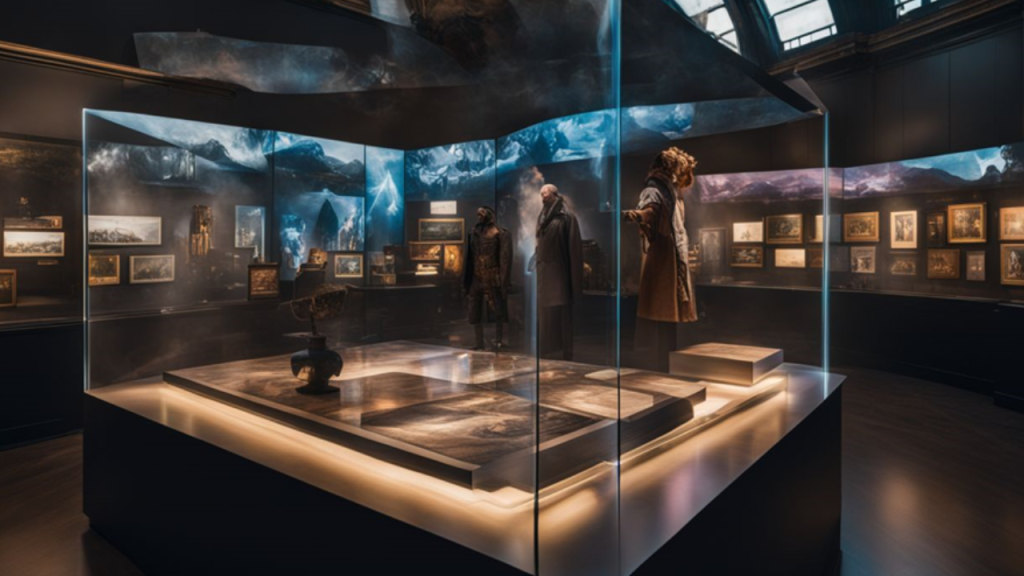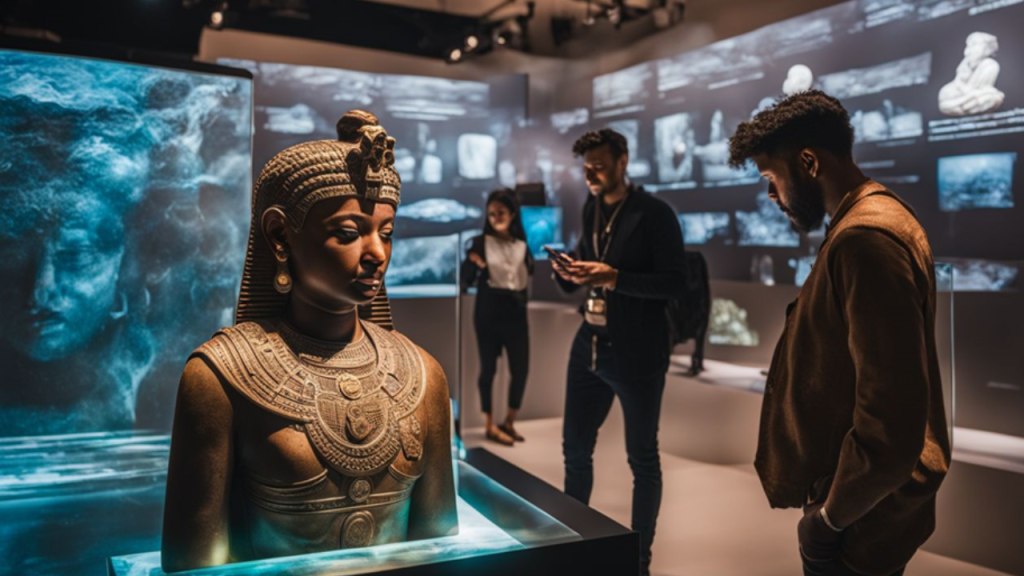
Struggling to visualize historical instances of racial violence and antisemitism? You’re not alone. Today, museums harness the power of artificial Intelligence and holograms to bring history startlingly alive – explicitly focusing on sobering periods like the Holocaust and Slavery.
This blog unfolds the technological revolution in the world of museology that enables more impactful interaction with past events than ever before. Let’s dive into this intriguing mix of technology and history!
Key Takeaways
- AI and holograms are used in the Illinois Holocaust Museum and the Legacy Museum to create interactive displays of real-life historical figures.
- These high-tech tools make history feel more real. They answer questions, share personal stories, and even show emotions using the pre-recorded voices of actual survivors or witnesses!
- Using special systems, these exhibits offer unique lessons about topics like racism from firsthand accounts that live on even if the people do not.
- AI also helps ensure all facts shared in museums are accurate. It cross-checks information from different sources before presenting it to visitors!
The Role of AI and Holograms in Museums
Advancements in technology are enabling museums to revolutionize the way they present history. Incorporating artificial Intelligence (AI) and holograms is pivotal in this transformation.
These AI-supported installations offer interactive experiences that extend beyond traditional static displays.
For instance, powerful strides have been made in using these technologies at The Illinois Holocaust Museum & Education Center and The Legacy Museum: From Enslavement to Mass Incarceration.
Here, visitors engage with lifelike historical figures through immersive displays powered by AI and holography, offering them unique insights into past events that once seemed remote or disconnected.
On entering these exhibits endorsing advanced technology systems like AI and holograms, visitors find themselves face-to-face with AI-enhanced 3D images of real-life holocaust survivors.
They can ask questions directly to the characters, who respond via an intricate audio-visual testimonial system driven by the digital algorithmic magic of generative AI. Questions asked evoke responses from pre-recorded answers featuring actual voices from Holocaust heroes such as Max Glauben or Aaron Elster, which fills us with awe about Human resilience and forgiveness every time their stories are told.
Tackling Difficult Topics: Holocaust and Slavery
Utilizing the power of AI and holograms in museums allows for a more comprehensive exploration of difficult topics such as the Holocaust and Slavery, articulating these historical narratives through compelling firsthand accounts, interactivity, and accuracy.
Preserving firsthand stories with AI
Artificial Intelligence (AI) plays a pivotal role in preserving the firsthand experiences and stories from crucial historical events like the Holocaust. Museums, such as the Illinois Holocaust Museum & Education Center, embrace this technology to give visitors an interactive experience.
They use holographic images of actual survivors, which are activated when museum-goers make queries. These questions get fed into an AI system that employs generative functionality and computational linguistics to produce apt responses mimicking each survivor’s unique voice and mannerisms.
Hence, AI is transforming history’s narrative by ensuring important firsthand testimonies survive generations beyond their sources while allowing us deeper insight through these engrossing ‘conversations.’
The use of holograms in Holocaust exhibits
Outstanding methods of engaging audiences have emerged in Holocaust exhibits, with holograms taking the lead. The Illinois Holocaust Museum & Education Center has pioneered this approach by integrating eye-catching technology into their displays.
In a powerful testament to human resilience and forgiveness, they present holograms of actual Holocaust survivors and witnesses for visitors to interact with.
The exceptionally immersive nature of these displays allows museum-goers to engage directly with history. Utilizing artificial Intelligence, intricate simulations are designed for so-called “conversations” between spectators and survivor holograms.
Various topics tackling bigotry, prejudice, or beliefs can be broached during these talks. This level of interactivity ensures that eyewitness accounts will continue to be heard even after all survivors have passed on – thereby securing an enduring educational resource against antisemitism and promoting Holocaust remembrance.
AI’s role in presenting slavery history
Artificial Intelligence is crucial in conveying stories of slavery at various museums, including The Legacy Museum in Montgomery, Alabama. AI helps to ensure historical accuracy by verifying information through algorithms from multiple sources and platforms.
It also presents enslavement narratives effectively using Interactive exhibits.
Adopting this high-tech tool enhances visitors’ educational experiences, allowing them to engage more profoundly with the grim realities of the past. For instance, Alabama’s Legacy Museum utilizes holographic technology powered by Artificial Intelligence, which creates lifelike representations of enslaved individuals recounting their tales drawn from preserved writings or testimonies.
This immersive learning experience allows audiences to interact directly with history on a previously unimaginable level.
Interactive Holograms: A New Way to Learn

Dive into interactive holograms, uncovering their role in immersive museum exhibits and understanding how a person transforms into a 3-dimensional visual element. Learn more about the intriguing process behind creating these living lessons from our past.
The process of becoming a hologram
Transforming into a hologram is an intellectual melding of technology and memory. First, actual Holocaust survivors and witnesses are captured in holographic form. Their images take on a 3D shape, allowing for a more immersive display for museum visitors. Then, questions posed by visitors are deftly processed by an AI system that crafts appropriate responses. More impressively, the AI generates audio that mimics the survivor’s voice, giving a sense of real-time conversation.
Additionally, the system generates video footage of the survivor, creating an illusion of them verbally responding to each query posed. As technology advances, these holograms can address complex and thoughtful questions about faith or perspectives over genocide incidents. Featured at the Legacy Museum in Montgomery, Alabama, interactive AI-generated exhibits bring back historical figures from enslavement times when they spring to life as visitors approach reconstructed holding cells.
How holograms are used in exhibits
Immersive technology like holograms revolutionizes museum exhibits, offering interactive and engaging experiences to educate visitors about historical events.
- The Illinois Holocaust Museum features a hologram of Holocaust survivor Aaron Elster as one of its main exhibits. Visitors can interact with the hologram by asking questions, which AI technology interprets to generate real-time responses from the holographic image.
- At The Legacy Museum in Alabama, holograms breathe life into history by portraying enslaved individuals. These cutting-edge displays use actual words of the enslaved people taken from recorded oral histories or written documents.
- Museums use 3D imaging systems that project images onto stages, creating near-realistic encounters for viewers. They combine these displays with relevant artifactual pieces and photos to provide an in-depth understanding of past events.
- Interactive exhibits are not just limited to addressing visitors’ questions but can replicate emotional states, too, pushing the boundaries of conventional education methods.
- Some museums use cloud-based learning systems and generative AI technologies to create responsive dialogues in holographic exhibitions for a more realistic experience.
- Taking museum education beyond physical boundaries, certain institutions allow access to their interactive experiences online, making it possible for people worldwide to engage with history like never before.
- Museums are even creating unique installations like ‘holographic barbers,’ where historical haircuts are brought back into fashion through the creative use of this advanced technology.
- To amplify accuracy and relevance, museums often work closely with survivors or direct witnesses while developing their hologram projects.
- These innovative displays also serve as critical tools for preserving firsthand testimonies as they capture personal narratives and stories directly from those who experienced traumatic events firsthand.
- Lastly, this merging of technology offers a promising path forward for preserving history and promoting empathy among future generations through lifelike exhibitions that give voice to those silenced by time.
AI’s Impact on Museum Exhibitions
Explore the transformational role of AI in museum exhibitions, offering interactive and immersive experiences that breathe new life into historical narratives. Discover how this technology enhances accuracy and broadens understanding of history like never before.
Dive deeper to learn how these cutting-edge tools shape the future of education in museums!
The interactive system of AI in museums
Artificial Intelligence (AI) revolutionizes how museums engage visitors with powerful interactive systems.
- Firstly, museums utilize AI to process visitor queries swiftly. This technology instantly analyses questions from guests and generates fitting audio and video responses.
- In the Illinois Holocaust Museum, holograms of actual Holocaust survivors answer a broad range of inquiries from patrons. Aided by AI, these lifelike holograms make the learning experience immersive and personal.
- Beyond simple Q&A, AI powers holograms to represent enslaved individuals in The Legacy Museum. These interactive displays perform actions such as singing or describing the horrors of their captivity, making history come alive for museum-goers.
- Furthermore, AI contributes significantly to ensuring historical accuracy. It allows the development of interactive virtual conversations with figures like Holocaust witness Aaron Elster, bringing his first-person testimony directly to patrons in an accessible format.
- With the support of Generative AI, these thought-provoking dialogues evolve based on real-time audience interaction. This promotes an understanding not only of historical events but also stimulates discussions on topics like racism, bigotry, and antisemitism.
- The use of AI extends beyond enhancing human interactions; it’s instrumental in curating artifactual aspects of enslavement exhibits. Leveraging computational GPS and big data analysis, AI can accurately place artifacts within their historic geographical context, enhancing their interpretive value.
AI’s contribution to historical accuracy
Artificial Intelligence enhances museums’ ability to present precise, detailed histories. Through AI-powered systems, institutions like the Illinois Holocaust Museum & Education Center and The Legacy Museum can generate accurate and realistic retellings of tragic events such as the Holocaust and Slavery.
For instance, specially tailored AI technology creates a simulated conversation with a Holocaust survivor by capturing their voice nuances and generating video responses appropriate for visitor inquiries.
This exceptional level of interaction provides visitors with an in-depth understanding of historical narratives based on firsthand experiences from survivors — thus combating bigotry through knowledge.
AI’s capacity to handle complex data sets also aids in translating artifactual aspects of enslavement into easy-to-understand displays that vividly illustrate humanity’s past struggles, contributing significantly towards preserving history’s vital accuracy.
Conclusion
Harnessing the power of AI and holograms offers revolutionary possibilities for educating museum visitors about challenging topics like the Holocaust and slavery. These cutting-edge technologies provide a more immersive, interactive learning experience.
They breathe life into historical narratives, transforming spectators into participants while ensuring traumatic events are never forgotten. By judiciously using technology, we can effectively fight bigotry and spread tolerance among future generations.



